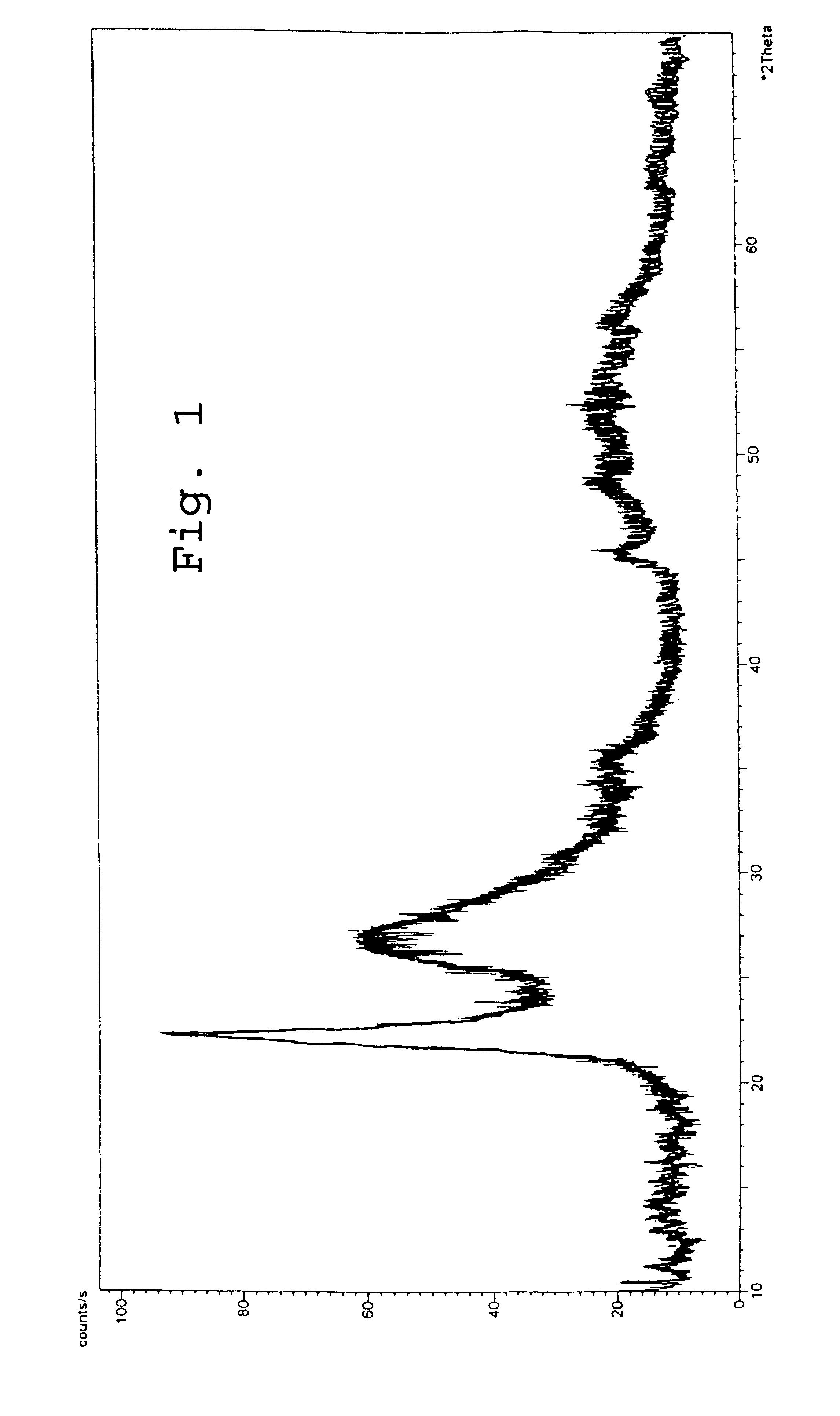Catalytic oxidation of alkanes to corresponding acids
a catalytic oxidation and acid technology, applied in the direction of carboxylic preparation by oxidation, metal/metal-oxide/metal-hydroxide catalysts, chemical/physical processes, etc., can solve the problem of low yield of acrylic acid at relatively high temperatures, no commercial process that exists based on propane oxidation to acrylic acid, and high cost of propylene separation
- Summary
- Abstract
- Description
- Claims
- Application Information
AI Technical Summary
Benefits of technology
Problems solved by technology
Method used
Image
Examples
example 1
[Mo.sub.1 V.sub.0,398 Ga.sub.1.0E-05 Pd.sub.1.90-04 Nb.sub.0.125 Te.sub.0.23 ]
Ammonium metavanadate (Aldrich Chemicals, Assay=99.0%) in the amount of 7.6 grams was added to 80 ml of distilled water and heated to 90.degree. C. with stirring. 3.4 grams of niobium oxide (80% Nb.sub.2 O.sub.5), 28 grams of oxalic acid, and 28.8g ammonium paramolybdate tetra hydrated (Aldrich Chemicals A.C.S.-12054-85-2) were added to the vanadate solution to make a gel mixture. The required amount of palladium followed by telluric acid and gallium oxide were added slowly to gel mixture. The gel mixture was stirred vigorously to achieve a homogeneous gel mixture which was then dried slowly to incipient dryness with continuous stirring.
The resulting solid was put in a China dish and dried additionally in an oven at 120.degree. C. The dried material was cooled to room temperature and placed in a furnace where the catalyst is calcined at 350.degree. C. for 4 to 16 hours. The temperature was raised from room...
example 2
[Mo.sub.1 V.sub.0.398 Ga.sub.1.0E-05 Pd.sub.1.90E-04 Nb.sub.0.125 Te.sub.0.23 La.sub.1.0E-05 ]
The procedure was the same as Example 1 except the required amount of lanthanum nitrate was also added in the last step of preparation.
The calcined catalyst was formulated into uniform particles of the 40-60 mesh size and evaluated for the propane oxidation reaction. The catalyst was evaluated at a temperature of 300.degree. C. using a feed mixture containing propane: oxygen: nitrogen (20:10:70). The reaction product showed the following results:
The overall reaction products showed 35% oxygenated product and 65% total oxidation product.
example 3
[Mo.sub.1 V.sub.0.398 Ga.sub.1.0E-05 Pd.sub.1.90E-04 Nb.sub.0.125 Te.sub.0.23 Zn.sub.1.0E-05 ]
The procedure was same as described in Example 1 except the required amounts of zinc nitrate and telleuric acid were also added in the last step of preparation. The calcined catalyst was formulated into uniform particles of the 40-60 mesh size and evaluated for the propane oxidation reaction. The catalyst was evaluated at a temperature of 300.degree. C. using a feed mixture containing propane: oxygen: nitrogen (20:10:70). The reaction product showed the following results:
The overall reaction products showed 42% oxygenated product and 58% total oxidation product.
PUM
| Property | Measurement | Unit |
|---|---|---|
| temperature | aaaaa | aaaaa |
| pressure | aaaaa | aaaaa |
| yield | aaaaa | aaaaa |
Abstract
Description
Claims
Application Information
 Login to View More
Login to View More - R&D
- Intellectual Property
- Life Sciences
- Materials
- Tech Scout
- Unparalleled Data Quality
- Higher Quality Content
- 60% Fewer Hallucinations
Browse by: Latest US Patents, China's latest patents, Technical Efficacy Thesaurus, Application Domain, Technology Topic, Popular Technical Reports.
© 2025 PatSnap. All rights reserved.Legal|Privacy policy|Modern Slavery Act Transparency Statement|Sitemap|About US| Contact US: help@patsnap.com



